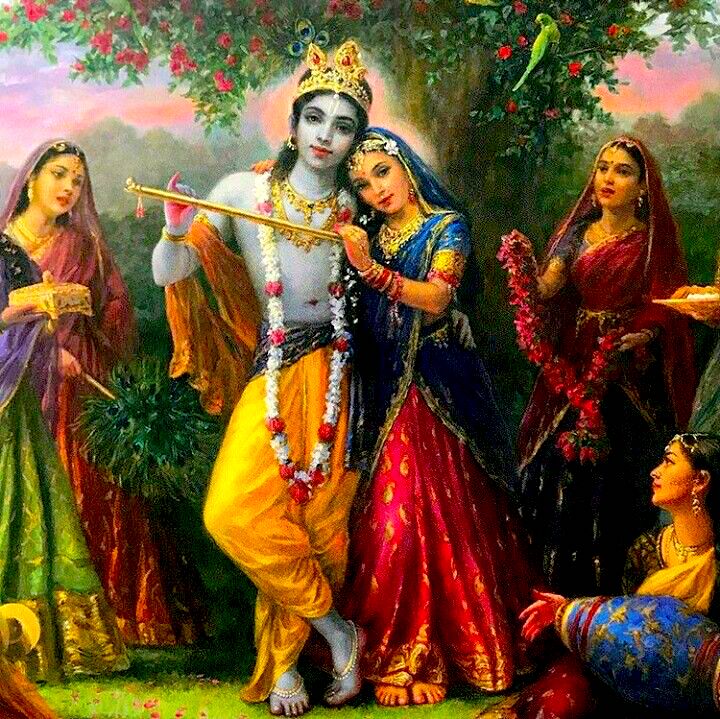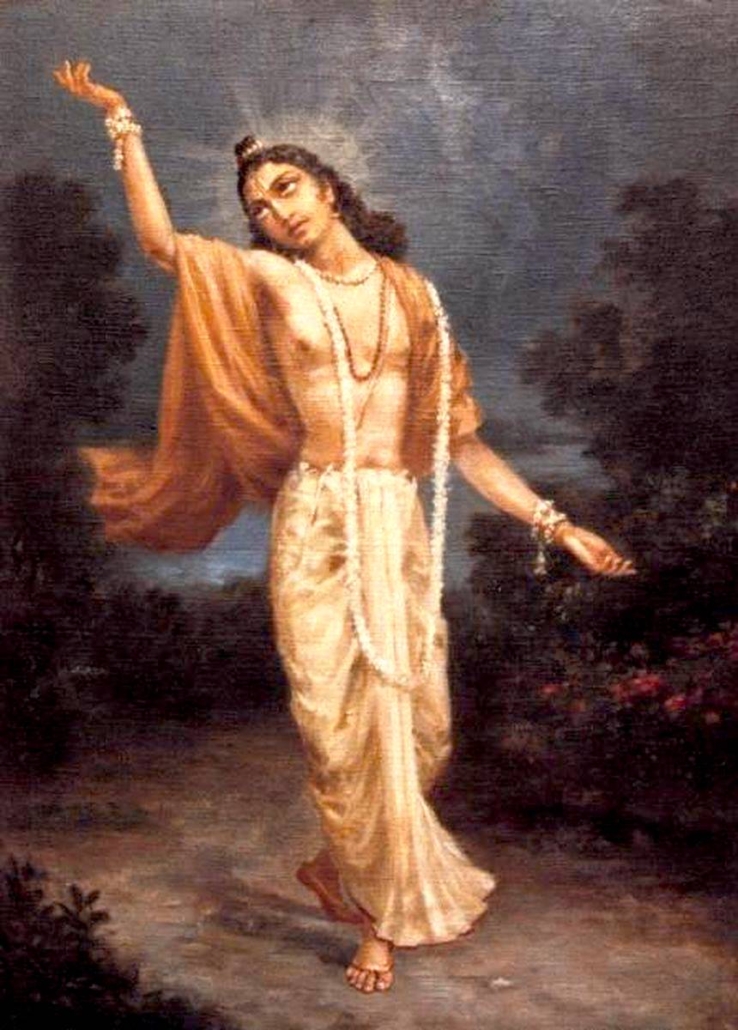Mahanidhi Madan Gopal Das
These amazingly sweet and charming nectar-filled verses will carry you into the realm of Srimati Radharani’s eternal seva. The original Sanskrit verses of Vrindavan Mahimamrita by Sri Prabodhananda Sarasvati are all incomparably beautiful and worthy of remembrance.
However, since most people cannot memorize Sanskrit verses, we have presented mostly just the English translations. These verses paint wonderful lila pictures for meditation on Radha Krishna’s Vraja lilas. And most importantly, they will help a sadhaka to adopt the feelings and sentiments, gopi-bhava, of a dasi of Sri Radha. The verses have titles to facilitate their remembrance.
Sataka 1.54 Manjari’s Fortune and Bliss
All the festivals of bliss experienced in relation to Bhagavan Sri Krishna don’t equal even one fraction of the happiness Radha’s manjaris experience when their eyes plunge in the ocean of Radha Krishna’s intimate pastimes.
If you want to experience the incomparable bliss of Radha’s manjaris, then simply give up your body in the topmost abode of Sridham Vrindavan.
Sataka 2.22 Manjari Sthayi-rati
Remember Radhika’s kinkaris (manjaris) who are full of madhurya rasa, the rapturous moods of srngar- rati, smara -rasamaya- radhika -kinkaris.
Sataka 2.39 Ecstatic Bliss
I worship the manjaris who become overwhelmed in bliss, and start rolling on the ground after continuously watching Radha Madhava’s wonderful playful amorous battle on a charming flower bed in a Vraja nikunja.
Sataka 2.56 Manjaris Intimate Sevas
I will serve Radha Krishna by offering fragrant forest garlands, smearing cooling sandalwood paste on Them, putting betel nuts in Their mouths, gently fanning Them, and massaging Their lotus feet when Radha Krishna lie down together enjoying the happiness of a tight loving embrace.
Sataka 2. 61 Beautiful Meditation on Radha
Overwhelmed by a flood of love, speaking with a broken voice, shedding tears, and the hair of Her body erect with excitement, Sri Radha sends Her dearest manjari to Krishna with a letter of humble apology (after a lover’s quarrel).
Later, when They meet again in the forest of Vrindavan, Radha falls at Krishna’s feet and binds Krishna’s feet with Her braided hair. All glories to the most beautiful Radharani who is the light of my life.
Sataka 2.84 Intimate Sevas
One day Radha sees a golden vine decorated with fresh buds and lovely smiling flowers oozing honey wrapped around a dark tamal tree. Suddenly Radha becomes overwhelmed with a desire to meet Krishna and starts to faint. But a clever manjari quickly supports Radha.
Sataka 2.86 Manjari Identity
Radha’s manjaris are like wonderful bubbles from the effulgent spiritual ocean of sweet love flowing from the beautiful lotus feet of Radha. O friend! Just become a follower of the kinkaris of Radhika, anusarata -sakhe -radhika -kinkaris -tah.
Sataka 2.95 Three Important Truths
Sri Chaitanya Mahaprabhu revealed that sadhakas of manjari bhava must always remember and meditate upon three spiritual truths, tattvas:
1. Sri Vrindavan Tattva
2. Radha Krishna Tattva
3. Nija Tattva
Nija tattva means the truth about yourself i.e. your siddha deha as revealed by Sri Gaurachandra, who inaugurated the practice of raganuga-bhakti which includes meditation upon one’s individual spiritual body.
sri- vrindavan -tattvam
sri- radha -krishna -tattvam
nija -tattvam -ca -sada -smara
yat -prakatitam -asti -gauracandrena
Sataka 3.1 Cultivating Gopi Bhava
Gradually, give up all activities that go against your internal mood and feelings as a manjari dasi of Srimati Radharani. Always remember that Radha Krishna are eternally staying in your heart.
With eyes of love always see that all the moving and non-moving entities in Vrindavan are absorbed in thoughts of Radha Krishna. You should not see in any other way. Day and night celebrate a great festival of serving Radha Krishna as They enjoy pastimes in the forest of Vrndavana.
Sataka 3.15 Nikunja Seva
O my beloved Madan Mohan! You are more enchanting than Kamadeva! When in the beautiful forest of Vrindavan will I serve You, who are smiling and agitated by intense amorous desires as You passionately lay on a bed of flowers in a nikunja with my Ishvari Radha, who rules my entire existence.
Jai Jai Sri Radhe! See part two manjari meditations.


